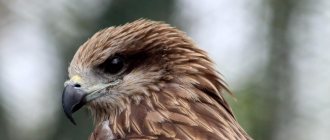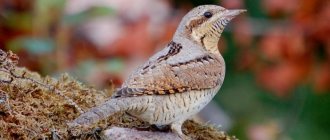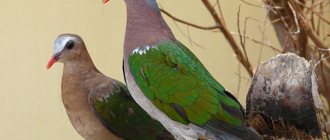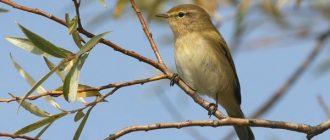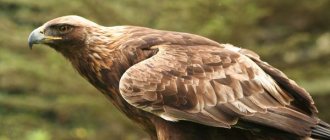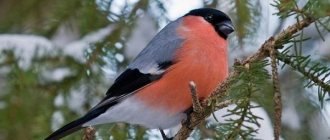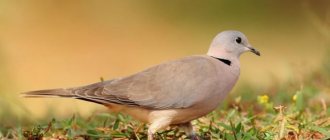- Wild animals
- >>
- Birds
The nightjar is a numerous genus of birds that feed on insects and prefer nocturnal life and daytime sleep. Often nightjars can only be seen near herds of animals. The bird's six subspecies vary, becoming smaller and paler east of its range. All populations migrate and winter in African countries. Birds have excellent camouflage, allowing them to be well camouflaged. They are difficult to notice during the day when they lie on the ground or sit motionless along a branch.
Origin of the species and description
Photo: Nightjar
The description of the nightjar was included in the 10th volume of the system of nature by Carl Linnaeus (1758). Caprimulgus europaeus is a species of the genus Caprimulgus (nightjars), which has 38 species since the 2010 taxonomic revision, according to the bird's breeding areas in Eurasia and Africa. Six subspecies have been established for the common nightjar, two of which are found in Europe. Differences in color, size and weight are sometimes clinical in nature, and sometimes less pronounced.
Video: Nightjar
Interesting fact: The name nightjar (Caprimulgus) translates as “goat milker” (from the Latin words capra - goat, mulgere - to milk). The concept is borrowed from the Roman scientist Pliny the Elder from his Natural History. He believed that these birds drink goat's milk at night, and in the future they can go blind and die from this.
Nightjars are quite often found near livestock on pasture, but this is most likely due to the presence of a large number of insects circling near the animals. The name, based on an erroneous theory, is not preserved in some European languages, including Russian.
Interesting facts about the bird
- Kozodev can often be seen near grazing domestic animals. In such places, birds hunt flies, horseflies and other types of insects that accompany domestic animals. Nightjars fly nearby and run on the ground between the animals, sometimes right among their feet. Such unusual habits, as well as the large mouth of the nightjar, became the reason for the appearance of this name for the bird. It is very difficult to spot a nightjar in the forest, but you can easily see cows or goats next to a herd.
Appearance and features
Photo: Nightjar in nature
Nightjars reach a length of 26 to 28 cm, with a wingspan of 57 to 64 cm. They can weigh from 41 to 101 grams. The standard base body color is gray to reddish brown with complex cryptic markings of white, black and various shades of brown. The body shape resembles that of a falcon with long pointed wings and a long tail. Nightjars have brown beaks, dark red mouths and brown legs.
Adult males have white ventral pharynxes, often divided into two distinct areas by a gray or orange-brown vertical stripe. The wings are unusually long, but rather narrow. A bright white stripe appears in the last third of the underside of the wing. The outer feathers of the long tail are also white, while the middle feathers are dark brown. There is a white pattern on the side of the upper wing, but it is less noticeable. Basically, you can distinguish a pure white stripe and bright color of the plumage in the throat area.
The roughly identical and equally heavy females lack white markings on the wings and tail and a bright throat patch. In older females, the throat area is clearly lighter than the surrounding plumage, with more of a reddish-brown color there. The plumage of the chicks is very similar to that of the females, but is generally lighter and of lower contrast than that of the adult females. In flight, the bird looks much larger and resembles a sparrowhawk.
Flight on long pointed wings is silent due to their soft plumage and very smooth. Molting in adults occurs after reproduction; during migration, the process is suspended, and tail and summer feathers are replaced during wintering grounds from January to March. Immature birds use a similar moulting strategy to adults, unless they are from late broods, in which case the entire molt may occur in Africa.
Now you know the time when the nightjar flies out to hunt. Let's find out where this bird lives.
The most common subspecies
Gigantic nightjars, in turn, are divided into several more subspecies. And the most common of them is considered to be the gray forest nightjar. It is found in southern Mexico, Argentina and Paraguay, as well as in the Antilles (with the exception of Cuba).
It is a large bird, the body length of which is approximately 38 centimeters, and the weight is two to three times higher than the corresponding indicators of the common nightjar. The plumage is gray (hence the name), with stripes and spots of black.
The bird's methods of obtaining food are the same as those of all gigantic birds - according to the flycatcher principle. And it disguises itself in the same way - as a branch of a stump.
The gray nightjar does not stand out in terms of its regime - it hunts at night and sleeps during the day, pretending to be a column. He pretends so well that you can even come close and touch him without suspecting anything!
He, like his other relatives, is a wonderful artist. Perhaps this quality is what makes the inconspicuous nightjars so unusual and attractive in the eyes of people.
Where does the nightjar live?
Photo: Nightjar bird
The nightjar's distribution range extends from northwestern Africa to southwestern Eurasia east to Lake Baikal. Europe is almost entirely inhabited by this species, and it is also present on most Mediterranean islands. The nightjar is absent only from Iceland, northern Scotland, northern Scandinavia and deep northern Russia, as well as the southern Peloponnese. In Central Europe it is a rare spotted breeding bird, more often found in Spain and Eastern European countries.
Nightjars range from Ireland in the west to Mongolia and eastern Russia in the east. Summer habitats range from Scandinavia and Siberia in the north to North Africa and the Persian Gulf in the south. Birds migrate to breed in the northern hemisphere. They winter in Africa, primarily in the southern and eastern reaches of the continent. In winter, Iberian and Mediterranean birds breed in West Africa, and migratory individuals have been recorded in the Seychelles.
The nightjar lives in dry, open landscapes with sufficient numbers of night-flying insects. In Europe, its preferred habitats are heaths and marshes, but it can also colonize light sandy pine forests with large open spaces. The bird is found, especially in southern and south-eastern Europe, in rocky and sandy areas and in small areas overgrown with bushes.
Nightjars are associated with a wide variety of habitat types, including:
- swamps;
- orchards;
- wetlands;
- boreal forests;
- hills;
- Mediterranean shrubs;
- young birch trees;
- poplars or coniferous plantations.
They do not like dense forest or high mountains, but prefer clearings, meadows and other open or lightly forested areas free from daytime noise. Closed forest areas are avoided by all subspecies. Deserts without vegetation are also not suitable for them. In Asia, this species is regularly found at altitudes above 3000 m, and in wintering grounds even on the edge of the snow line at an altitude of about 5000 m.
Distribution area
This bird lives in many parts of the world. It can be found in Eurasia, Africa, Europe, some regions of Russia, Central and South America. It is not found in Scandinavia, Iceland and the northern regions of Scotland.
She prefers to settle in dry, well-warmed areas. Also, its nests can be seen in swamps, river valleys, fields, the outskirts of clearings, thinned pine forests, wastelands and heather heaths. The nightjar is a bird that migrates over fairly long distances every year. She chooses her new place of residence taking into account the climate and the availability of sufficient food. It winters in dry and warm regions.
What does the nightjar eat?
Photo: Gray Nightjar
Nightjars prefer to hunt at dusk or at night. They catch flying insects with their wide mouths using short beaks. The victim is mostly captured in flight. Birds employ a variety of hunting methods, from the versatile, cunning exploratory flight to the hawk-like, furious hunting flight. Only shortly before catching up to its prey does the nightjar tear off its widely split beak and set up effective nets using obliquely projecting bristles that surround the beak. The bird rarely hunts on the ground.
The bird feeds on a variety of flying insects, which include:
- mole;
- Zhukov;
- dragonflies;
- cockroaches;
- butterflies;
- mosquitoes;
- midges;
- mayfly;
- bees and;
- spiders;
- praying mantis;
- flies
Sand or fine gravel was often found in the stomachs of individuals examined by scientists. Which the nightjar consumes to help digest its prey and any plant material that is ingested unintentionally while hunting other food items. These birds hunt not only in their territories, but sometimes make rather long flights in search of food. Birds hunt in open habitats, forest clearings and forest edges.
Nightjars pursue prey in a light, sinuous flight, and drink by descending to the surface of the water during flight. They are attracted to insects concentrated around artificial lighting, near farm animals, or over standing bodies of water. These birds travel an average of 3.1 km from their nests to feed. Chicks may eat their own feces. Migrating birds survive on their fat reserves. Therefore, fat is stored before migration to help the birds travel south.
Nutrition
The nightjar begins to feed in the evening. His favorite food is insects. Nightjars catch them near rivers, above the surface of swamps and lakes, over meadows where herds of animals graze. Insects grab on the fly. Therefore, the bird's flight is fast, often changing direction.
Birds hunt in the dark. The ability to echolocation, which is common among nocturnal birds and bats, is found in the Guajaro, a close relative of the common nightjar, so close that the Guajaro is called the fat nightjar. Most species of nightjars do not have this ability. They rely on their eyesight to hunt.
In case of large concentrations, insects are caught on the fly. The bird makes a non-stop flight around a swarm of winged invertebrates. Another style of hunting is also practiced. While on a branch, the bird looks out for a beetle or a large night moth. Having caught the victim, it returns to its observation post.
Among insects, preference is given to flying invertebrates. Gluttony and anatomical features make it possible to eat large beetles, which there are few people willing to eat. May beetles, crickets, and grasshoppers are eaten.
Sedentary arthropods are also included in the diet. Some species of nightjars catch small vertebrates. It is not easy for the stomach to cope with such food, so sand, pebbles and pieces of plants are added to regular food.
Features of character and lifestyle
Photo: Nightjar in Russia
Nightjars are not particularly sociable. They live in pairs during the mating season and can migrate in groups of 20 individuals or more. Same-sex flocks can form in Africa during the winter. Males are territorial and will vigorously defend their nesting grounds, fighting other males in the air or on the ground. During the daytime the birds are at rest and often sit facing the sun to minimize contrasting body shadow.
The nightjar's activity phase begins shortly after sunset and ends at dawn. If the food supply is sufficient, more time will be spent resting and cleaning at midnight. The bird spends the day resting on the ground, on stumps or on branches. In the breeding zone, the same resting place is usually visited for weeks. When danger approaches, the nightjar remains motionless for a long time. Only when the attacker has approached a minimum distance does the bird suddenly take off, but after 20-40 meters it calms down. During takeoff, an alarm sound and flapping of wings are heard.
Fun fact: In cold and inclement weather, some species of nightjar can slow down their metabolism and will maintain this state for several weeks. A nightjar has been observed in captivity that could maintain a state of torpor for eight days without harm to its body.
The flight can be fast, like falconry, and sometimes smooth, like the flight of a butterfly. The bird moves along the ground, stumbling, its body swaying back and forth. He loves to sunbathe and take dust baths. Like other birds such as swifts and swallows, nightjars quickly dive into water and clean themselves. They have a unique toothed, comb-like structure on the middle claw that is used to clean the skin and possibly remove parasites.
Chicks
Chicks usually do not hatch from their eggs at the same time. The interval between the appearance of the eldest and the youngest can be a whole day. Baby nightjars come into this world ugly, with ugly proportions. But they take on a “civilized” appearance quite quickly. As, in fact, independence.
They are active and energetic. Already two weeks after birth they try to take off, after three they fly quite well, and after five they no longer need parental care and leave their native “nest” to independently prepare for the upcoming flight to warmer climes.
Social structure and reproduction
Photo: Nightjar chick
Breeding occurs from late May to August, but may occur much earlier in northwestern Africa or western Pakistan. Returning males arrive approximately two weeks before females and divide territories by chasing intruders by flapping their wings and making intimidating sounds. Battles can take place in flight or on the ground.
The male's display flights involve a similar body position with frequent wing flapping as he follows the female in an upward spiral. If the female lands, the male continues to hover, swaying and fluttering, until his mate spreads his wings and tail for copulation. Mating sometimes takes place on higher ground rather than on the ground. In good habitat there may be 20 pairs per km².
The European nightjar is a monogamous bird. It does not build nests, and eggs are laid on the ground among plants or tree roots. The area may be bare soil, fallen leaves, or pine needles. This location has been in use for a number of years. The clutch contains, as a rule, one or two whitish eggs with spots of brown and gray shades. Eggs average 32 mm × 22 mm and weigh 8.4 g, of which 6% is shell.
Fun Fact: Several species of nightjars are known to lay eggs two weeks before the full moon, possibly because the insects are easier to catch when the moon is full. Research has shown that the phase of the moon is a factor for birds that lay eggs in June, but not for those that do so earlier. This strategy means that the second brood in July will also have a favorable lunar aspect.
Eggs are laid at intervals of 36–48 hours and are incubated primarily by the female, starting with the first egg. The male may incubate for short periods, especially at dawn or dusk. If the female is disturbed during breeding, she will run away from the nest, feigning a wing injury, until she distracts the intruder. Each egg hatches in 17–21 days. Fledging occurs after 16–17 days, and the chicks become independent from adults 32 days after hatching. A second brood may be raised by early breeding pairs, in which case the female leaves the first brood several days before they can fly on their own. Both parents feed the young insect pellets.
Living conditions
In order for a nightjar to live calmly and comfortably, it needs the following conditions: A large number of nocturnal insects. Good review. Dry litter. The ability to suddenly leave the nest if a predator suddenly happens to be nearby. All this ideally corresponds to transparent pine forests, where there is enough sunlight and insects, and the sandy soil is dry and warm.
Also quite suitable are clearings, clearings, wastelands and wastelands, which are often favored by the nightjar bird. And if for many other birds deforestation becomes disastrous, here it is the other way around - the population only increases as a result of such human actions. Nightjars also sometimes settle in river valleys, on the slopes of ravines, in abandoned quarries, on military training grounds, in the steppes... But the proximity to busy highways is like death for them. The fact is that the light of car headlights attracts various midges. And, trying to catch their dinner, the night birds fall right under the wheels.
Natural enemies of nightjars
The mysterious coloration of this species allows the birds to hide themselves in broad daylight, perching motionless on a branch or stone. When threatened, nightjars feign injury to distract or lure predators away from their nests. Females sometimes lie motionless for long periods of time.
Often, when repelling a predator's attack, shaking the spread or raised wings while screaming or hissing is used. When alarmed chicks open their bright red mouths and hiss, it may give the impression of a snake or other dangerous creature. As the chicks mature, they also open their wings to give the appearance of a larger size.
Known predators of the nightjar include:
- common viper (V. berus);
- foxes (V. vulpes);
- Eurasian jays (G. glandarius);
- hedgehogs (E. europaeus);
- Falconiformes;
- raven (Corvus);
- wild dogs;
- owls (Strigiformes).
Nightjar eggs and chicks are susceptible to predation by red foxes, martens, hedgehogs, weasels and domestic dogs, as well as birds including crows, Eurasian jays and owls. Snakes can also rob a nest. Adults are attacked by birds of prey including northern hawks, sparrowhawks, common buzzards, peregrine falcons and falcons. In addition, the parasites on its body cause inconvenience to the bird. These are lice found on the wings, feather mites, found only on white feathers.
Captive
The nightjar is a wild bird that has very strange features and camouflages itself in the tropical forests where it lives.
It is better for him to live in his natural habitat. If it so happens that the bird is brought home and put in a cage, it may get sick, and in some cases this can lead to death. Nightjars are nocturnal insectivores that produce a unique nocturnal moaning sound that is more eerie than pleasant. This sound can be quite disturbing in the home. There is no reason why a wild bird should be kept in captivity and forcefully tamed.
It belongs to its natural habitat. In very rare cases, it is possible to remove a bird from its habitat, especially when you are rescuing it from a potential disaster. Even then, it is necessary to return the bird to the jungle after you have taken care of it.

